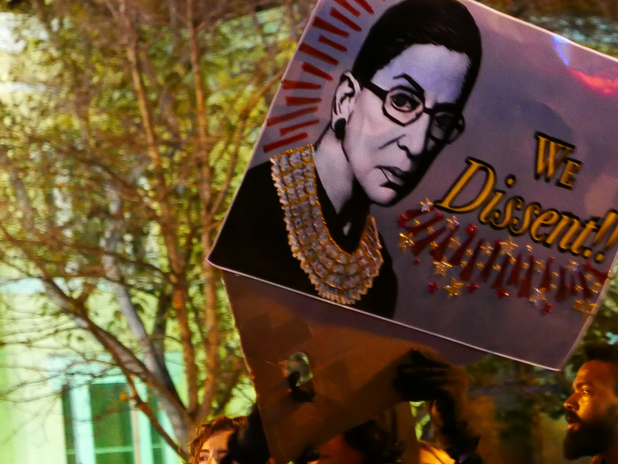Ruth Bader Ginsburg, the second woman on the Supreme Court and a champion for women’s rights, passed away in her home on September 18th, 2020, after battling cancer for the fifth time. As we remember R.B.G. for her work in law, love of the opera, and “super diva” sweatshirt, we reflect on how far our society has come in granting women access to the same rights as men. The idea of a woman in law was far from reality in the 1950s. Ruth Bader Ginsburg was one of nine women in a law class of 500 willing to change that dynamic. As we reflect on the “Notorious R.B.G.” and her 87-year legacy, let us acknowledge how far women have come and how much further we have left to go.
Her Upbringing
The daughter of immigrants, Ruth Bader Ginsburg went on to be a symbol of the American Dream. However, before getting to that point she faced years of adversity and challenges that, ironically, would not hinder her but instead make her stronger. For starters, her mother, Celia, battled cancer during Ruth’s teenage years, later passing before her daughter’s high school graduation. Celia passed on her dreams of continuing her education beyond high school to Ruth. According to Ruth, her mother advised her “… to be a lady. And for her that meant to be your own person, be independent,” already instilling the beliefs that women were capable without men. On top of that, her college sweetheart and husband, Martin Ginsburg, was diagnosed with cancer, and Ruth stood up to the challenge of attending law school full-time while taking care of their newborn daughter. Marty was “the first man who cared [she] had a brain” and never felt intimidated by her abilities. In fact, he used his privilege as a white male to fight for Ruth, pushing for firms to hire her and later campaigning in front of senators for her to be confirmed for the Supreme Court. The constant reinforcement from Marty went to show how a man could use his power to help a woman succeed. There is no doubt that the ones closest to Ruth had a significant influence on her character.
In law school, Ginsburg and the eight other women were ridiculed for “taking the place of a man.” Ginsburg later went on to become the first woman to make the Harvard Law Review, later graduating first in her class at Columbia Law School. Straight from law school, it was difficult to get hired. Ginsburg said, “Not a law firm in the entire city of New York would employ me… I was Jewish, a woman and a mother,” demonstrating that no matter how successful she was, as long as there were laws in place to hold back women and there were no laws granting them more freedom, there would always be a boundary between a woman and her chances at success.
Her Landmark Cases
When she co-founded the Women’s Rights Projects of the American Civil Liberties Union (ACLU), Ginsburg was finally in the position to fight gender discrimination after experiencing it for her entire life. The ACLU provided her with the traction she needed to make the courts and the public aware of the gender discrimination that had been present since this country’s founding. She argued six cases in front of the Supreme Court, winning five, and later joined them. Below are a few of the many cases she fought and ruled on.
1971 – Reed v. Reed: Struck down the idea that lenders could require women to have male cosigners on loans.
1972 – Frontiero v. Richardson: Decided that requiring different criteria for military spousal dependency infringed on the Fifth Amendment’s Due Process Clause and discriminated against women.
1974 – Weinberger v. Wiesenfeld: Declared gender-based distinctions that said a female worker’s family was less protected than a male’s a violation of the Fourteenth Amendment’s Due Process Clause after Stephen Wiesenfeld was unable to receive benefits after the passing of his wife.
1978 – Duren v. Missouri: Declared the exemption of women from jury duty a violation of the Sixth and Fourteenth Amendment after Jackson County selected an all-male jury when women made up 54% of the population.
1996 – United States v. Virginia: Decided that qualified women could not be denied admission to military institutes.
Ultimately, these cases showed the duality of gender-based discrimination, that it affected not only women but men too. It’s difficult to believe these laws were able to stand without being challenged for so long. However, when you remember that very few women had ever been in the position to represent themselves and countless others in law, it becomes evident why women were so overlooked.
Her Court
After Justice Bryon White retired in 1993, President Bill Clinton took the chance to interview Ruth Bader Ginsburg as the 101st Associate Judge of the Supreme Court, but only the second woman. “When I’m sometimes asked when will there be enough [women on the Supreme Court] and I say, ‘When there are nine,’ people are shocked. But there’d been nine men, and nobody’s ever raised a question about that.” This statement reflects how there are still groundbreaking moments in women’s history that have not occurred yet, that there is still more for us to achieve. There’s no doubt Ruth embodied what it means to be a woman on the Supreme Court in the face of adversity. She expressed her femininity alongside Justice O’Connor with their collared robes originally designed with a man in mind. Her small stature did not come in the way of her mighty dissenting opinions. She proved that women had the ability to be civil and lady-like while still putting up a fight against gender roles. Justice Ginsburg’s tenure in the Supreme Court would be shaped by liberal ideas as she maintained the 5-4 split in ideology (with liberal justices as the minority). She unified their voice and became known as “the great dissenter” as she challenged the majority. Tackling everything from gender discrimination and abortion rights to affirmative action and voting rights, it is clear that Justice Ginsburg prioritized equal rights and challenged long-lived laws.
Despite their differences, the Supreme Court is a tight-knit group of colleagues whose goal is to shape the law in the way they believe benefits the American people most. Although they have different views on how to get there, the respect among the court for each other’s opinions and their ability to challenge each other shows how invested they were in upholding the law of the land. All of the justices have expressed their condolences for Ginsburg and her family, but at the same time, they played just as big of a role in her life as them.
Her Legacy
In pop culture, the deserving nickname, “Notorious R.B.G,” will continue to stay relevant in the midst of our current civil rights movement. However, notorious is an understatement. R.B.G. has affected all of our lives—both women and men—whether that be directly or indirectly by tackling the issue of gender-based discrimination through the law, something that came to the justice system unanticipated, yet so long overdue. As we see more women in law from all backgrounds, we can more easily envision a future where we will be able to better represent the American people and their need for equal rights in the justice system. Although there is a long way to go, R.B.G. expanded this idea throughout her lifetime as she always challenged the status quo. As we continue to honor R.B.G. and all she has done for us, it’s important to recognize the great loss we have experienced. We’ve lost a fighter for equal rights, and we must compensate for this by creating a new generation of young leaders who will echo activists like R.B.G. for decades to come.
Rest in Peace.


